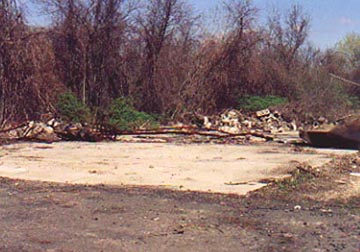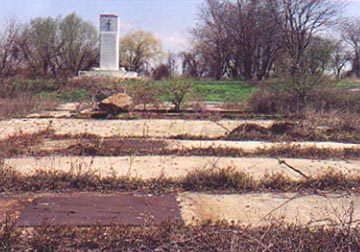|
Lonely and windswept, Hart Island remains one of New York's
best-kept secrets. Those New Yorkers familiar with the island are most
likely to know it as the location of the city's cemetery or "Potter's
Field". Few, if any, are aware of the island's Cold War role as a guided missile installation.
About text, photos |
|
Although the Army abandoned its Hart Island Nike missile site nearly 40 years ago, numerous traces of the base remain visible today. Some Army buildings have been adapted by the Department of Correction to serve new purposes. Others were either removed or demolished. Much of the site has simply been abandoned to the elements. These buildings, structures and ruins are fascinating artifacts from a particularly tense and frightening period during the Cold War. All of the color photographs on this page were taken during a brief official visit to Hart Island in April 2000.
|
Copyright 2000 by Donald E. Bender. Text & images. All Rights Reserved. |
Due to its relative isolation, the 101-acre island has been the setting for a variety of rather unusual activities over the past 135 years. A prison camp for Confederate soldiers was established at the north end of the island in 1865. Three years later, Hart island was purchased by the City of New York to use as a cemetery for indigent or unclaimed persons, a function which it continues to serve to this day.
The New York City Department of Correction established a workhouse for minor offenders on the island in 1895. During the Second World War, this facility was replaced by a disciplinary barracks operated by the U.S. Navy. Following the war, Hart Island featured (at various times) a facility for derelict men, a rehabilitation center for drug addicts and an annex for the Riker's Island correctional facility.
Perhaps the most unusual and least-known chapter in Hart Island's recent history, however, was its use by the U.S. Army Air Defense Command as a "Nike" missile installation for seven years during the Cold War.
Named for the mythical Greek goddess of victory, Nike
missiles were surface-to-air missiles designed to shoot down enemy aircraft. Over a period of roughly two decades during the Cold War,
Nike missiles were deployed at roughly two-hundred sites within the
continental United States. Operated by the United States Army Air Defense
Command (ARADCOM), the missiles provided a vital last line of defense against the threat of a nuclear attack by long-range Soviet aircraft. The Army's first Nike installation became operational during the spring of 1954 at Fort George G. Meade in Maryland.
 | ARMY PIER
The Army transported personnel, equipment and Nike missiles (broken down into major components) to Hart Island by means of a substantial pier seen in the background above. In the foreground is an abandoned guard post constructed by the NYC Correction Dept.
|
New York and most other major American cities were defended by the Army's Nike missiles. The air defense requirements of the sprawling
metropolitan area demanded that Nike missile sites be established at no fewer than 19 locations within the Army's New York Defense Area. The missile sites were located within New York City, on Long Island, in Westchester and Rockland counties and in New Jersey.
One of the first Nike missile sites constructed within the
New York metropolitan area was a site known as Nike missile battery
"NY-15." Site NY-15 was also one of the most unusual Nike installations, for its facilities were constructed on two separate islands located
in the extreme western portion of Long Island Sound.
The site's headquarters and its Control Area (containing the
site's radars and the ground-based missile guidance equipment) were
located on Davids Island, near New Rochelle. Its Launcher Area (containing the missiles and< the launching infrastructure) was constructed on nearby Hart Island. By building on these two islands, the Army was able to quickly
establish site NY-15 with a minimum of effort, avoiding the often difficult
and contentious process of acquiring parcels of privately-owned
land from individual owners.
 | MISSILE ASSEMBLY & TEST BUILDING (Ruins)
The fins and control surfaces of the missiles were attached within the building that stood here where also their internal guidance equipment was tested before they were moved to the adjacent fueling and warheading area. A portion of the curving concrete path over which the missiles were moved can be still be seen at the north end of the foundation.
|
Davids Island was already under federal control. It was the site of Fort Slocum, a seacoast fort established during the mid-19th century to defend the approaches to New York City. During the latter half of the 20th century, Fort Slocum served as a headquarters for various military commands and was also the site of several armed forces schools. Due to the location of its headquarters and Control Area at this installation, Nike missile site NY-15 was also known as the Fort Slocum Nike missile battery.
The limited size of Davids Island, however, dictated that the Launcher Area containing the missiles had to be located elsewhere. Hart Island, located some two miles to the southwest, provided a relatively easy solution in this situation. The island was already owned by the City of New York. Due to its use by the Department of Correction, casual visitors were not permitted. Hart Island's proximity to Davids Island, and the clear and unobstructed "line of sight" between the two islands (an essential requirement of the Nike ground-based guidance and control system) made it an appropriate location for the Army's new missile launching facility.
 | CRANE - ACID FUELING AREA
The most dangerous operations were performed within a compound here where sloping earthen walls (now largely obscured by vegetation) were constructed to deflect the force of an accidental explosion. The missiles received their liquid fuel/oxidizer mixture here and the warheads were inserted before the missiles were joined to their booster rockets. The crane was used to lift and move the missiles and other components.
|
Nike missile battery NY-15, the only missile site within to New York metro area to be located entirely on two offshore islands, was declared operational during 1955. It was initially designated as Battery "D" of the Army's 66th Anti-Aircraft Missile Battalion. Headquartered at historic Fort Totten in northern Queens, the 66th Battalion also controlled three additional Nike missile batteries defending the New York metropolitan area.
Nike missile site NY-15's Launcher Area was situated within a narrow parcel of land within the northern half of Hart Island. The Launcher Area
contained all of the facilities needed to assemble, test, store and launch
the site's compliment of twenty supersonic Nike Ajax missiles.
One important function of the Launcher Area was the initial assembly and
testing of the missiles. Due to Interstate Commerce Commission regulations
restricting shipments of explosive materials, Nike Ajax missiles had to be
shipped to Nike missile sites nationwide in an unassembled condition. Major
components (missile bodies, fins, booster rockets and warheads) were
transported to the Hart Island site by means of a special pier complex
constructed by the Army on the island's western shore.
| 


